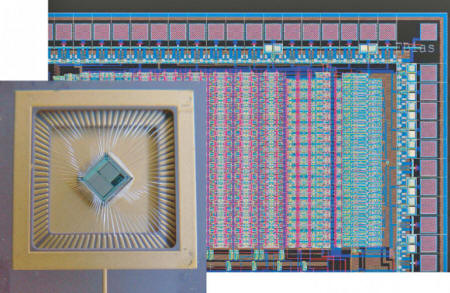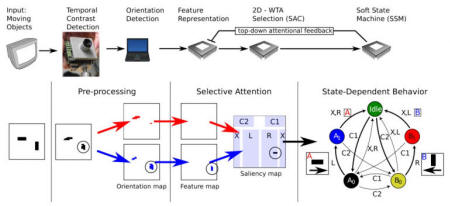|
Swiss researchers have taken an important step towards imitating the brainís information processing
Researchers at the University of Zurich and ETH Zurich have designed a sophisticated computer system that is comparable in size, speed and energy consumption to the human brain.
Based on the development of neuromorphic microchips that mimic the properties of biological neurons, the research is seen as an important step in understanding how the human brain processes information and opens the door to fast, extremely low-power electronic systems that can assimilate sensory input and perform user-defined tasks in real time. Neuromorphic engineering
The human brain is a remarkable machine: with a power consumption of only about 20 W, it can outclass the fastest supercomputer in most real-world tasks - particularly those involving the processing of sensory input.
Researchers believe that the brain's astounding abilities aren't down to mere processing speed, but rather to the highly efficient way in which it elaborates information.
Though we lack the tools to fully investigate the brain's "computing architecture," we know,
Established in the late 1980s, neuromorphic engineering is an interdisciplinary amalgam of neuroscience, biology, computer science and a number of other fields that attempts first to understand how the brain manipulates information, and then to replicate the same processes on a computer chip.
The goal is the development of new, powerful computing architectures that could be used to model the brain and, perhaps, even serve as a stepping stone to a sophisticated, human-like artificial intelligence.
Most attempts at replicating a human brain involve simulating a very large number of neurons on a supercomputer.
The neuromorphic approach, however, is quite different because it involves developing custom electronic circuits that simulate the neuron firing mechanisms in the actual brain and are similar to the brain in terms of size, speed and energy consumption.
The silicon neurons, Giacomo Indiveri told us, are comparable in size to actual neurons and they consume very little power.
Compared to the supercomputer approach, their system consumes approximately 200,000 times less energy - only a few picojoules per spike.
A neuromorphic chip uses its most basic components in a radically different way than your standard CPU. Transistors, which are normally used as an on/off switch, here can also be used as an analog dial. The end result is that neuromorphic chips require far fewer transistors than the standard, all-digital approach.
Neuromorphic chips also implement mechanisms that can easily modify synapses as data is processed, simulating the brain's neuroplasticity.
Soft state machines
Promising as they may be, neuromorphic neurons have proven difficult to organize in cooperative networks to perform a user-defined task.
The Zurich researchers have now solved this problem by developing a sort of elementary structure - what they called a "soft state machine" (SSM) - that can be used to describe and implement complex behaviors in a neuromorphic system.
In computer science, a finite state machine (FSM) is a mathematical model similar to a flowchart that can be used to design computer programs and logic circuits. FSMs can implement context-dependent decision-making, "if-A-then-do-B" clauses, and use a short-term memory of sorts.
SSMs are neuronal state machines similar to FSMs that combine analog and digital signal processing. As such, they can be used to describe a complex behavior in a neuromorphic chip.
The behavior can be first described in terms of a standard finite state machine, and then automatically translated into a SSM that can be implemented on a neuromorphic chip.
A smarter silicon retinaThe researchers tested their findings on an advanced electronic camera known as silicon retina with a visual-processing-based task inspired by those used to evaluate the cognitive abilities of human subjects.
Aside from real-time visual processing, the task also requires memory and context-dependent decision making, elements that are commonly accepted as signs of cognition.
Interestingly, the neural structures that form as this visual test is performed has shown a remarkable similarity with neural structures in the mammalian brain.
Applications
This work sheds light on how the neural networks in the brain implement the higher cognitive functions, and offers some valuable insights as to how future neuromorphic chips could go about increasing performance even further.
In the more immediate future, the researchers will combine the chips with several sensory components at once, such as an artificial cochlea or retina, to create complex cognitive systems that interact with their surroundings on multiple levels, all in real time.
A paper detailing the team's work was published on the journal Proceedings of the National Academy of Sciences (Synthesizing cognition in neuromorphic electronic systems).
Source
|



